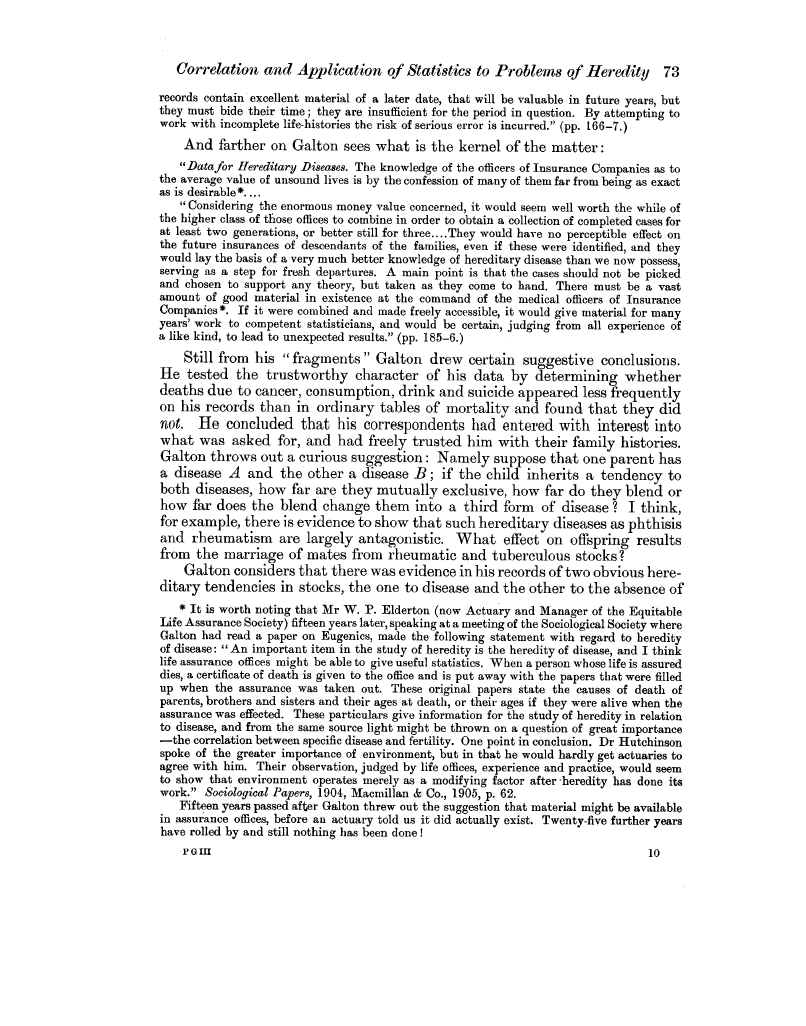| ||||||

OCR Rendition - approximate
Correlation and Application of Statistics to Problems of Heredity 73 records contain excellent material of a later date, that will be valuable in future years, but they must bide their time ; they are insufficient for the period in question. By attempting to work with incomplete life-histories the risk of serious error is incurred." (pp. 166-7.) And farther on Galton sees what is the kernel of the matter "Data for Hereditary Diseases. The knowledge of the officers of Insurance Companies as to the average value of unsound lives is by the confession of many of them far from being as exact as is desirable*.... "Considering the enormous money value concerned, it would seem well worth the while of the higher class of those offices to combine in order to obtain a collection of completed cases for at least two generations, or better still for three... .They would have no perceptible effect on the future insurances of descendants of the families, even if these were identified, and they would lay the basis of a very much better knowledge of hereditary disease than we now possess, serving as a step for fresh departures. A main point is that the cases should not be picked and chosen to support any theory, but taken as they come to hand. There must be a vast amount of good material in existence at the command of the medical officers of Insurance Companies*. If it were combined and made freely accessible, it would give material for many years' work to competent statisticians, and would be certain, judging from all experience of a like kind, to lead to unexpected results." (pp. 185-6.) Still from his " fragments " Galton drew certain suggestive conclusions. He tested the trustworthy character of his data by determining whether deaths due to cancer, consumption, drink and suicide appeared less frequently on his records than in ordinary tables of mortality and found that they did not. He concluded that his correspondents had entered with interest into what was asked for, and had freely trusted him with their family histories. Galton throws out a curious suggestion : Namely suppose that one parent has a disease A and the other a disease B ; if the child inherits a tendency to both diseases, how far are they mutually exclusive, how far do they blend or how far does the blend change them into a third form of disease? I think, for example, there is evidence to show that such hereditary diseases as phthisis and rheumatism are largely antagonistic. What effect on offspring results from the marriage of mates from rheumatic and tuberculous stocks? Galton considers that there was evidence in his records of two obvious hereditary tendencies in stocks, the one to disease and the other to the absence of * It is worth noting that Mr W. P. Elderton (now Actuary and Manager of the Equitable Life Assurance Society) fifteen years later, speaking at a meeting of the Sociological Society where Galton had read a paper on Eugenics, made the following statement with regard to heredity of disease : ° I An important item in the study of heredity is the heredity of disease, and I think life assurance offices might be able to give useful statistics. When a person whose life is assured dies, a certificate of death is given to the office and is put away with the papers that were filled up when the assurance was taken out. These original papers state the causes of death of parents, brothers and sisters and their ages at death, or their ages if they were alive when the assurance was effected. These particulars give information for the study of heredity in relation to disease, and from the same source light might be thrown on a question of great importance -the correlation between specific disease and fertility. One point in conclusion. Dr Hutchinson spoke of the greater importance of environment, but in that he would hardly get actuaries to agree with him. Their observation, judged by life offices, experience and practice, would seem to show that environment operates merely as a modifying factor after -heredity has done its work." Sociological Papers, 1904, Macmillan & Co., 1905, p. 62. Fifteen years passed after Galton threw out the suggestion that material might be available in assurance offices, before an actuary told us it did actually exist. Twenty-five further years have rolled by and still nothing has been done ! P G III 10
|